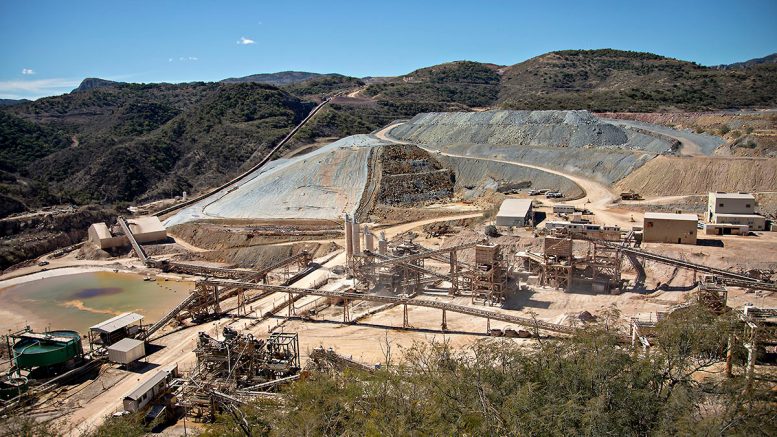When Alamos Gold (TSX: AGI; NYSE: AGI) paid Placer Dome $10 million for the Mulatos project in Mexico in November 2001, gold was below US$300 per ounce.
At that gold price, recalls John McCluskey, the company’s president and CEO, “Mulatos didn’t look very promising – nothing did at that time – but we entered into the agreement on the assumption that the gold price would rise and it did within six months.”
Construction of the open-pit mine, 220 km east of the city of Hermosillo in the Sierra Madre Occidental mountain range of Sonora state, began in the summer of 2004, and the company poured first gold in July 2005.
Mulatos turned out to be full of surprises. While a feasibility study at US$370 per oz. gold predicted a seven-year mine life that would take the heap-leach operation out to 2012, the asset has defied the odds and continues to produce gold to this day. Indeed the company is about to start pre-stripping yet another satellite pit with a five-year mine life. That deposit – 7 km from the main Mulatos pit — is called La Yaqui Grande and will extend production to 2027.
The Mulatos mine complex has grown to six pits and produced over 2 million oz. gold, generating more than $400 million in free cash flow since 2005.
“We always knew the district had great potential and all the geologists were saying so, but that has turned out to be the case,” McCluskey says in an interview. “There are enough stories out there about deposits yielding far fewer ounces than people expected, and this is one of the cases where that whole complex keeps yielding more and more ounces than anyone expected.”
The company will start construction of the fully permitted La Yaqui Grande pit this quarter, McCluskey says, and it should be producing gold in the third quarter of 2022.
An internal economic study of La Yaqui Grande released in late July estimates average annual production of 123,000 oz. gold over five years. Production from La Yaqui Grande, the company says, will replace higher-cost production from the main Mulatos pit, and keep combined production at 150,000 oz. gold per year.

Alamos Gold’s La Yaqui Grande open pit project in Mexico. Credit: Alamos Gold.
The study estimates all-in sustaining costs (AISCs) at La Yaqui Grande of US$578 per oz., which should reduce AISCs of the Mulatos district from the mid-point of the company’s previous 2020 guidance of US$960 per ounce.
Initial capex of US$137 million will be spent over a two-year period, and much of it will be internally generated from revenues from the Mulatos complex should gold remain above US$1,750 per oz., according to the company. At a base case gold price of US$1,450 per oz., La Yaqui Grande would generate an after-tax net present value at a 5% discount rate of US$165 million and an internal rate of return of 41%. At US$1,750 per oz. gold, the NPV jumps to US$260 million and the IRR to 58%.
The mine plan used in the internal study was based on mineral reserves of 19.2 million tonnes grading 1.17 grams gold per tonne and 15.88 grams silver per tonne for 724,000 contained oz. gold and 9.8 million contained oz. silver.
Excluded from the mine plan were measured and indicated resources of 43,000 oz. gold and 340,000 oz. contained silver within 1.3 million tonnes grading 1.01 grams gold per tonne and 8 grams silver.
McCluskey says the rich oxide material at La Yaqui Grande reminds him of what Alamos mined from the main Mulatos pit for much of its production history.
“We had to do a pre-strip on it, which took us seven or eight months, and then we got into the upper oxides, which were very, very good grade, similar to the kinds of grades you see at La Yaqui Grande,” he says. “We were able to mine through those oxides for many years, and that was the portion of the orebody that would work at a very low gold price.”
Fifteen years after mining the main Mulatos pit began, the company has extracted all the oxides, and the majority of the material it is mining and will be mining for the next three or four years is mixed in sulphide ore, which doesn’t get good recoveries and is lower-grade at 0.85-0.9 gram gold. As a result, production costs have gone up.
Once Alamos starts mining La Yaqui Grande, McCluskey says, it will be mining initial grades of between 1.1 grams gold and 1.3 grams gold. “We’re starting fresh again. We’re at the top of the orebody — it’s oxide material and very good grade.”
The company will also utilize grid power for the entire development of La Yaqui Grande, he says, which will trim costs. In addition, the royalty the company was paying on the first 2 million oz. gold fell away in the first quarter of 2019.
As a founding asset for the company, Mulatos has delivered far more than it promised.
“For mining open-pit oxide this is one of the great gold systems in the world. I think it ranks as the sixth-largest epithermal high-sulphidation field in the world and that would include ground we don’t control,” McCluskey says of the Mulatos district. “Nineteen kilometres to the north of us is Agnico Eagle’s La India operation, and they’ve done relatively well there in addition to what we have, so it’s easy to argue, when you start putting it altogether, that all the resources that have been identified there will be climbing well north of six million ounces.”






Be the first to comment on "Mulatos mine keeps paying off for Alamos Gold"